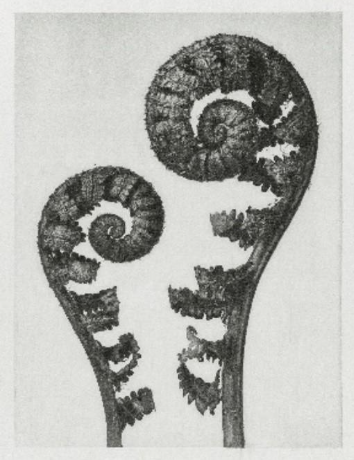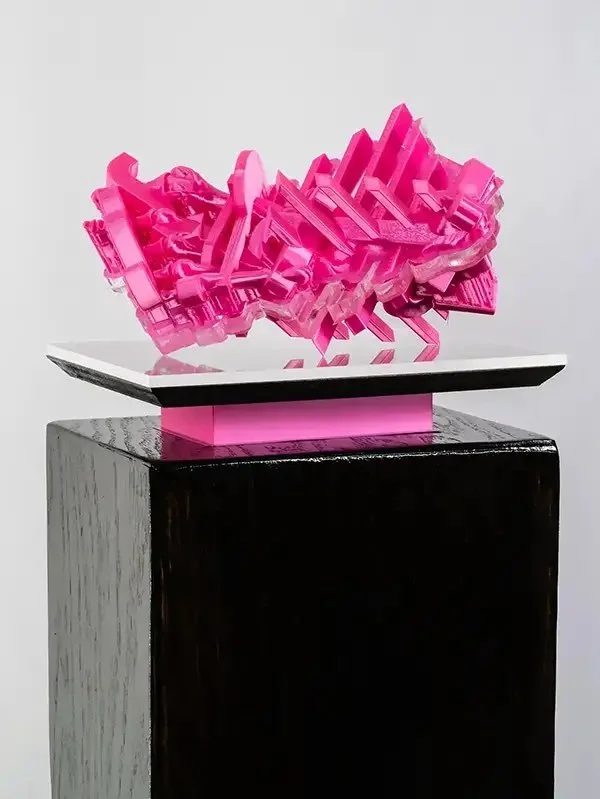READING LIST
on silence and the latent image
By Daniel Cosentino
Daniel Cosentino, Jaw, 2024. PLA 3D-printed sculpture, acrylic, and wood, 9 x 9 x 9 inches. © Cosentinoworks, Daniel Cosentino.
For this year’s “Reading List” column, the artist Daniel Cosentino features a selection of books and manifestos that have advanced his thinking about his own practice.
Last fall I exhibited new works for an exhibition called On Silence with Romeo Di Loreto, a professor of photography at the University of Texas Rio Grande Valley. The show emerged from several conversations we’d had about silence. The theme was the catalyst, but not the destination. During the period leading up to the exhibition, my work turned inward. I began to fashion boldly-colored, 3D-printed sculptures of dissected bones and other bodily remnants. I wanted the work to embody silence as a relic might—as if the forms were fragments from history or memory, objects separated from their original context.
This turn in my practice owes much to the concept of the “latent” image in photography—the phenomenon where an invisible or undeveloped image must undergo processing before it is fully realized. In a conceptual sense, the latent image embodies potential: something present but unseen, waiting for a process to bring it forward. As a latent image holds within it the seeds of a new image, so too does a “silent” relic contain the hidden story of its past.
By exploring my library with this concept as a catalyst, I could connect disparate works and discover a similarly latent thread connecting them. The books I am indebted to come from a range of disciplines—photography, ecology, poetry, and gender studies, among others—but all have contributed to my interest in silence and its generative potential. This reading list, then, amounts to a manifesto of sorts for silence and latency.
***
Legacy Russell – Glitch Feminism: A Manifesto, Verso, 2020.
Donna Haraway – “A Cyborg Manifesto,” from Simians, Cyborgs, and Women: The Reinvention of Nature, Routledge, 1991.
I first encountered Glitch Feminism by Legacy Russell during a recent residency, when E. Jane, an artist discussed in the manifesto, saw “glitch” in my bone sculpture Jaw (see above). In this piece I transformed a bone, an unseen anatomical element into something fractured, split, and exposed. Russell defines the glitch as a disruption that reveals societal cracks and hidden structures where new identities can emerge. In this sense, the concept is related to the idea of the latent image, which must be activated by some kind of process to become visible. While my practice isn’t situated in the realm of social activism, I found a connection to its political potential through the “glitch.”
The notion of embracing fractures brings me to “A Cyborg Manifesto” by Donna Haraway, a critical precursor to Glitch Feminism. Haraway reimagines identity through the cyborg: a hybrid being that transcends binaries like organic/machine and male/female. Russell’s “glitch” originates within the digital, breaking down conventions of performance and identity, while the cyborg opens space for alliances that embrace multiplicity and fluidity. Both frameworks treat rupture as a point of entry, whether as a technological error or hybrid identity, where latent meanings can manifest as acts of resistance or proposals for new combinations.
***
Karl Blossfeldt – Art Forms in the Plant World: 120 Full-Page Photographs, Dover Publications, 1986.
Originally Published: Urformen der Kunst [Art Forms in Nature], Ernst Wasmuth, 1928
For my recent series of sculptures, I began with three-dimensional scans of human bones—spines, jaws, pelvises, hands and feet—that had been created for educational purposes. I think of my process in photographic terms. A 3D-print of jaw bone, for instance, is essentially a digital simulacrum of the natural world, which I then subject to dissection and layering to reveal latent structures and forms within. From the outset, I intuitively connected this work to Karl Blossfeldt’s photographs of botanical forms. Though created as scientific teaching aids, these images were also meant to inspire architectural design. With Blossfeldt’s images, as with my sculptures, form transcends purpose.
Karl Blossfeldt, Aspidium Filix Mas (Shield Fern Fronds), enlarged four times from Urformen der Kunst, 1928. Rijksmuseum.
Geoffrey Batchen – Burning with Desire: The Conception of Photography, MIT Press, 1999.
Rosalind Krauss – “Photography’s Discursive Spaces: Landscape/View.” Originally published in Art Journal 42, no. 4, 1982.
The title Burning with Desire is drawn from a letter by photographic pioneer Louis Daguerre and expresses his urgent search for a way to permanently fix an image. Batchen takes this as a starting point to look both forward and back from the moment history marks as the “beginning” of the photographic enterprise. The book challenges this understanding of the technology’s emergence, showing us how Daguerre’s innovation was but one discovery in a series of related discoveries. Batchen’s overview of this past reveals how photographic methods are driven by a deep human yearning—not merely to depict the visible, but to grasp the unseen, to fix an image of something elusive. This notion of desire resonates with my own exploration of forms that challenge direct representation. In my work I aim to evoke what is latent within nature—unseen realities embedded in biological structures like bones—creating images that occupy a space between silence and revelation, just as photographic processes once sought to render visible what was fleeting, immaterial, or even spiritual.
In “Photography’s Discursive Spaces: Landscape/View,” Rosalind Krauss examines the work of Eugène Atget, whose enigmatic photographs of early twentieth-century Paris offer more than mere documentation. Krauss argues that Atget’s images resist traditional narrative structures, presenting absence, fragmentation, and ambiguity. These photographs compel viewers to engage with both what is shown and withheld. Krauss calls this the “photographic referent.” Atget’s void-like urban landscapes evoke a stillness, drawing attention to the spaces between presence and absence—an idea that resonates with the broader themes explored throughout this list.
Daniel Cosentino, Spine, 2024. PLA 3D-printed sculpture, acrylic, and wood, 9 x 9 x 9 inches. ©Cosentinoworks.
Stephanie Dalley (Editor and Translator) – Myths from Mesopotamia: Creation, The Flood, Gilgamesh, and Others, Oxford University Press, 2009.
E. E. Cummings – Tulips & Chimneys, Liveright, 1923 (first edition).
Nothing in art is truly satisfied by technical analysis, as we ultimately understand the world through story. In searching for the oldest relics, I turn to objects and stories from ancient Mesopotamian cultures. In The Epic of Gilgamesh, one of the oldest tales ever recorded, the hero’s turmoil following the death of his friend Enkidu nearly drives him to madness. Gilgamesh’s anguish propels him into a violent and introspective journey that reveals the fragility of human existence. This theme is poignantly expressed through the broken, translated form of the narrative that emerges from damaged tablets nearly lost to us. As these artifacts demonstrate, a relic’s fragmentary nature suggests a missing wholeness, kindling in our imaginations a way to complete the meaning of the form.
E. E. Cummings’ Tulips & Chimneys is another poetic work I’ve turned to for inspiration. His use of punctuation, line breaks, and disruptions create unexpected pauses and silences. Similarly perhaps, the fractured elements in my work evoke moments of absence and reflection. Interruptions in form parallel the stillness found in nature, the fragmentation of relics, and the layered meaning within ancient texts. In Spine (above), for instance, interspersed bones, letter forms, and symbols act as a kind of reimagined poetic structure.
Daniel Cosentino, Foot, 2024. PLA 3D-printed sculpture, acrylic, and wood, 9 x 7 x 9 inches. ©Cosentinoworks.
Italo Calvino – Invisible Cities, Harcourt Brace Jovanovich, 1978.
William Eggleston, Mark Holborn – William Eggleston: The Democratic Forest, Steidl, 1989.
I first encountered Invisible Cities during a period of reflection on proportions, balance, and absence within my own work. Calvino’s cities are not just physical spaces; they are conceptual landscapes where the visible and invisible, the planned and the organic, coexist. Each city operates on both macro and micro scales, where grand elements govern smaller interactions, and those smaller actions in turn define the larger whole. Through Invisible Cities, Calvino offers not just a meditation on space but a reminder that meaning arises from the dynamic tension between what is present and what is withheld. This tension mirrors the metaphor of a latent image emerging.
Calvino’s novel led me to the extraordinary visions of the ordinary in William Eggleston’s The Democratic Forest. In these works, Eggleston takes seemingly banal spaces and transforms them into compositions of vivid significance. I am drawn to his use of color, but more so to his critique of hierarchies of meaning and value.
In my early years I experienced a crisis in my studies, where the banal began to appear more valuable than the precious. Rather than seeking out master paintings and examples of grand architecture, I was drawn to immediate, everyday spaces. I experienced something similar when I began accepting plastics as a viable sculptural material alongside organic materials or metals more commonly associated with the art of sculpture. Eggleston’s approach reframes the mundane as visually and emotionally resonant, challenging us to see each detail of the world around us as essential–even though it normally exists in a kind of latency.
Daniel Cosentino is a New Jersey-based multimedia artist and educator whose work spans photography, sculpture, and mixed media. He holds a BA in Philosophy from Rutgers University, a Post Baccalaureate Certificate in Studio Arts from SACI (Florence), and an MFA in Imaging Arts/Photography from Rochester Institute of Technology. His work has been featured in numerous galleries in the U.S. and Europe, and his recent site-specific installations and sculptures examine the dialogue between natural and constructed worlds.




